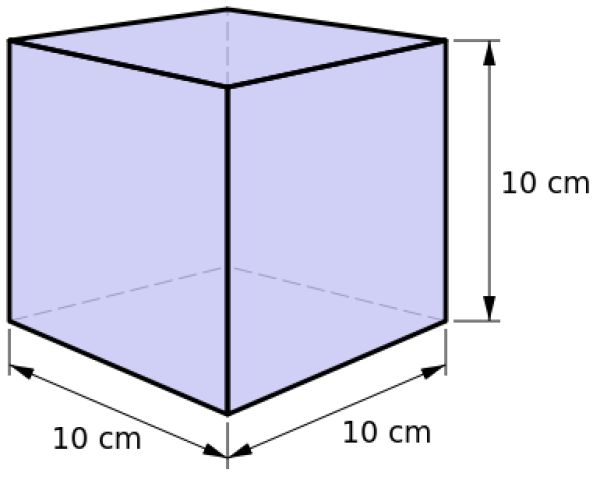Litre
![]()
This article is about the unit of volume. For the Hungarian municipality see Litér, for the painter see Ernst Litter.
The (outside Switzerland also: the) liter is a unit for volume and is represented by the unit sign 


One liter corresponds to one cubic decimeter (dm³). A cube with an edge length of 10 cm therefore has a volume of one litre.
Although the litre is not part of the International System of Units (SI), it is permitted for use with the SI. By national law, the litre is a legal unit of measurement.

A cube with an edge length of 10 cm has a volume of one liter.
Notation
The German unit name liter [ˈliːtɐ, also: ˈlɪtɐ] comes from French litre [from Middle French litron (a hollow measure), Middle Latin litra, Greek lítra = pound].
In principle, in the International System of Units (SI), unit symbols are only capitalised if the unit is named after a person; thus, the unit symbol for the litre is a lower-case l.
The capital L, which is mainly used in English-speaking countries, was exceptionally approved by the CGPM as an alternative unit symbol for the litre in order to avoid confusion of the letter l with the digit 1, which can occur in some fonts. ISO and IEC use only the original unit symbol l. IUPAC and DIN 1301-1 allow both notations.
Occasionally, a lowercase l in cursive (ℓ) is also used to distinguish the unit symbol from the numeral 1 or the uppercase letter I. The associated Unicode code point for the "ℓ" is U+2113. The unit name liter used to be neuter according to DIN 1301-1. However, this no longer coincided with common usage. The Duden, for example, mentions the neuter form only in second place. With DIN 1301-1:2010-10, this definition was changed from DIN 1301-1:2002-10; the unit name litre is now defined as masculine.
History
In 1793, the litre was introduced in France as the new republican unit of measurement (in connection with the metric system) and was equated with a cubic decimetre.
In 1879, the CIPM adopted the French liter definition and mandated the use of the l (lowercase l) as a symbol.
In 1901, the litre was redefined at the third CGPM to that volume which 1 kg of pure water has at the temperature of its highest density under normal pressure (1013.25 hPa). The liter was thus about 1.000 028 dm³ in size (originally 1.000 027 dm³ was given for the conversion). Due to the new task for this unit of measurement of coupling mass and volume via a special measurand of water, pure water under these conditions still had a density of 999.975 kg/m³, but now exactly 1.000 kg/l.
In 1964, at the 12th CGPM, the definition of 1793 was restored. Since then, a litre has again been exactly one cubic decimetre, and water has a density of 0.999 975 kg/l, as it did before 1901.
In 1979, at the 16th CGPM, the alternative symbol L (capital letter L) was approved for the litre; at the same time, the wish was expressed to keep only one of the two symbols (lower case or capital letter) in the future. Finally, in 1990, it could only be stated that it was still too early for a decision.
Questions and Answers
Q: What is a litre?
A: A litre (or liter) is a metric unit of volume. It is equal to the volume of 1000 cubic centimetres, which is equivalent to a cube of 10 x 10 x 10 centimetres.
Q: How much does one litre of water weigh at 4°C?
A: One litre of water at 4°C has the mass of exactly one kilogram.
Q: What are liters usually used for?
A: Liters are usually utilized to measure the volume of liquids, as the density can vary greatly. However it can also be applied to solids as well.
Q: What symbol is used for litres?
A: The symbol for litres is l or L, and sometimes the script letter ℓ is also used.
Q: Are there smaller units than litres?
A: Yes, there are smaller units than litres such as decilitres (10 dl = 1 litre), centilitres (100 cl = 1 litre), and millilitres (1000 ml = 1 litre).
Q: Why might someone use capital "L" instead of small "l"?
A: Some people prefer to use capital "L" instead of small "l" because it can look like the number one "1".
Search within the encyclopedia